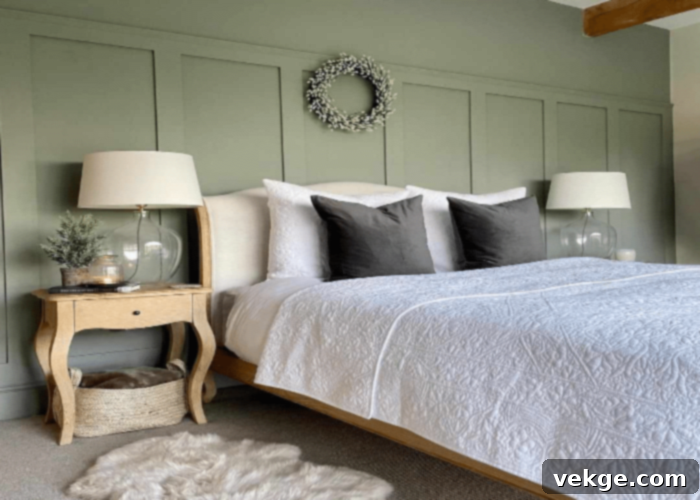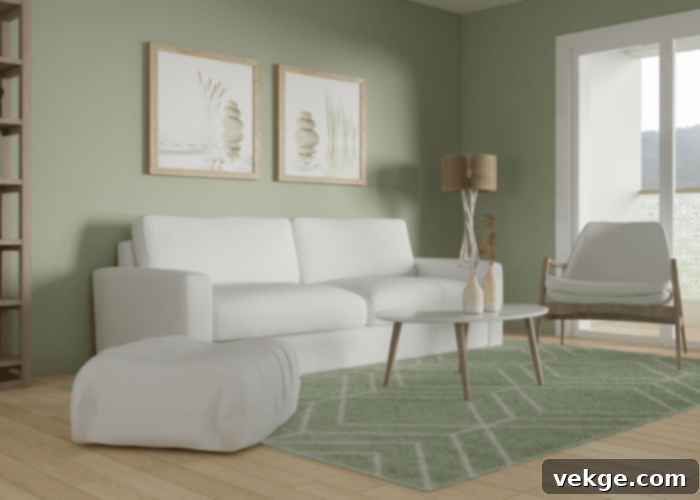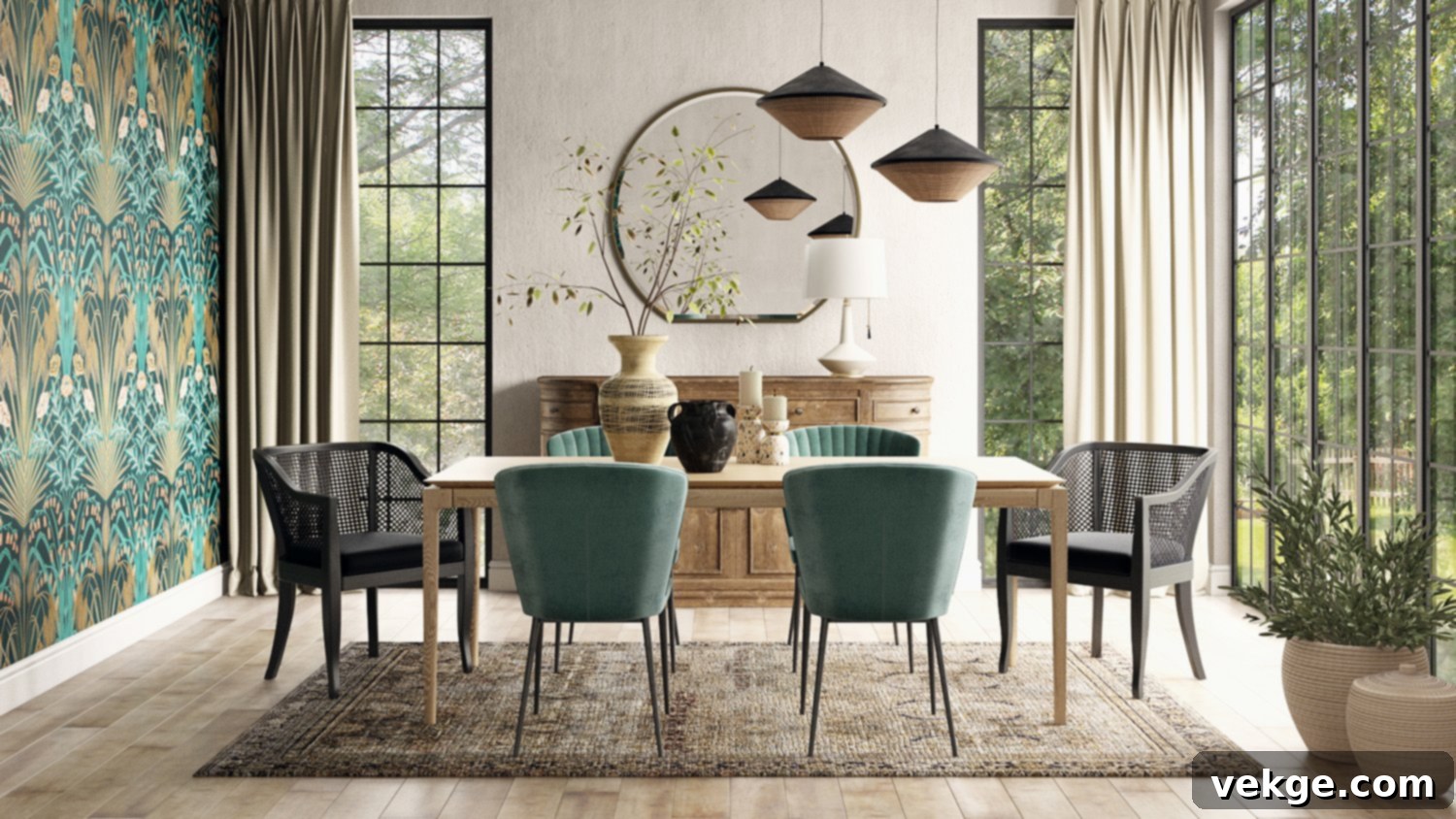The Ultimate Guide to Decorating with Sage Green: Pros, Cons, and Expert Tips for a Harmonious Home
In the realm of interior design, certain colors transcend fleeting trends, offering enduring appeal and profound emotional benefits. Sage green is undoubtedly one such hue. This exquisite, muted green, reminiscent of the aromatic herb and the serene quiet of nature, possesses an inherent ability to soothe the mind, reduce stress, and evoke a sense of balance and harmony. Its subtle grayish undertones give it a sophisticated, timeless quality that can transform any space into a tranquil sanctuary.
From the lightest whispers to deeper, more saturated tones, sage green offers a diverse palette, making it incredibly versatile for various design aesthetics. But as with any significant design choice, questions often arise: Will it truly complement my home? How can I effectively integrate it into my existing decor? If you’re pondering these very questions, this comprehensive guide is designed to illuminate the path, exploring the myriad benefits and potential drawbacks of embracing sage green for your interior and exterior decorating projects.
Exploring the Shades of Sage Green: A Deep Dive into Its Pros & Cons
Before committing to a color, understanding its full impact is essential. We’ve compiled a detailed look at the advantages and considerations when using various shades of sage green on your walls and throughout your home decor.
The Pros of Decorating with Sage Green

1. A Profoundly Calming and Stress-Reducing Effect
Sage green is intrinsically linked to the natural world, a connection that goes beyond mere aesthetics. Its gentle, earthy tones mimic the soothing hues found in forests and meadows, instinctively triggering a sense of peace and relaxation. This color is not just visually appealing; it taps into our innate biophilic tendencies, promoting a feeling of being enveloped by nature’s tranquility. Much like the herb sage, which is revered in aromatherapy for its calming and health-boosting properties – aiding in stress reduction and even digestion – the color translates these benefits into your living space. Applying sage green to walls can help create an oasis of calm, making it an ideal choice for bedrooms where relaxation after a demanding day is paramount, or in meditation rooms and bathrooms to foster a spa-like serenity. Its timeless nature ensures that this calming effect will remain relevant and cherished for years to come.
2. Remarkable Ability to Maximize and Expand Smaller Spaces
One of the most valuable attributes of sage green, particularly its lighter variations, is its capacity to make rooms feel more expansive and open. Light colors reflect more ambient light, pushing walls visually outward and tricking the eye into perceiving greater depth. This makes lighter sage green shades an excellent choice for smaller rooms, apartments, or areas that lack abundant natural light, such as internal hallways or windowless bathrooms. When paired with complementary light-colored furnishings and reflective surfaces, sage green can amplify the sense of space, transforming cramped areas into airy, inviting environments. Its versatility also means you can easily combine it with a wide array of other colors, further enhancing its space-maximizing potential without sacrificing style.
3. Adds Intriguing Depth and Dimension to Any Room
Beyond its ability to make spaces feel larger, sage green is also a master at introducing complexity and visual interest. By selecting the right shade – perhaps a slightly deeper, more saturated sage – you can craft a dramatic accent wall that becomes the focal point of a room. This technique works wonders even in the most modest of spaces, providing a distinct character and room-defining depth. But its application isn’t limited to entire walls; consider more unconventional uses to achieve unique effects. Painting interior trims, doors, or even the inside of shelves and closets in a sage green hue can add unexpected pops of color and sophisticated dimension, drawing the eye and highlighting architectural features. Experiment with varying shades to create subtle contrasts and layered aesthetics that feel both modern and timeless.
4. Darker Shades Offer Practicality by Concealing Dirt and Imperfections
For high-traffic areas or homes with active lifestyles, the practical benefits of darker sage green shades become evident. These deeper tones are remarkably effective at camouflaging everyday dust, minor scuffs, and small stains that might quickly become noticeable on lighter surfaces. This means your interior or exterior walls will maintain a cleaner, fresher appearance for longer periods, reducing the frequency of deep cleaning or touch-ups. When coupled with high-quality, durable paints, darker sage green can help your walls resist the visible accumulation of grime, ensuring they look vibrant and well-maintained for an extended duration. This low-maintenance aspect makes it an ideal choice for busy households, children’s rooms, or even commercial spaces.
5. Exceptional Versatility: Sage Green Thrives Anywhere
Few colors boast the chameleon-like adaptability of sage green. It is one of those rare hues that transitions seamlessly between exterior and interior applications, and within the home, it can find a comfortable and beneficial place in virtually every room. In the living room, it fosters a welcoming yet sophisticated atmosphere. As noted, in the bedroom, its calming properties promote restful sleep. In a home office or study, its natural essence can subtly boost concentration and productivity by reducing visual clutter and promoting a focused environment. Transform your bathroom into a tranquil spa-like retreat with sage green walls, or infuse your kitchen with a peaceful, earthy vibe that makes cooking and dining a more harmonious experience. Its universal appeal lies in its inherent balance – neither too warm nor too cool, allowing it to adapt effortlessly to various lighting conditions and design styles.
The Cons and Considerations When Decorating with Sage Green

1. The Challenge of Perfect Color Combinations
While sage green is highly versatile, achieving the “ultimate look” hinges significantly on selecting the right complementary colors. Missteps in this area can easily diminish its inherent charm and create an unbalanced, uninspired space. Sage green, being a muted and often cool-toned color, requires thoughtful pairing. Experts widely agree that it shines brightest when combined with a palette of neutrals such as crisp whites, warm creams, sophisticated grays, and delicate powdery pinks. These colors allow sage green to emerge as a subtle hero without being overwhelmed. For those daring to introduce deeper, more dramatic accents, consider rich plum hues, opulent golds, rustic terracotta or rust accents, earthy mustard yellows, or even striking black. These bolder choices can provide a beautiful contrast, especially with lighter sage green shades, adding depth and contemporary flair. Deep burgundy also makes for an unexpectedly luxurious pairing, elevating the space with its rich tones.
2. The Importance of Natural Materials to Enhance Sage Green’s Appeal
Given sage green’s deep roots in nature, it naturally resonates most harmoniously with organic and natural materials. Deviating too far from this principle by introducing overly synthetic or highly polished, artificial elements can inadvertently detract from the color’s inherent beauty and soothing vibe. To truly bring out the best in a sage green room, embrace materials that echo its natural origins. Think rich, warm wooden floors and furniture, rustic beams, or the subtle textures of porous stone and glazed ceramics. Upholstery in natural fibers like linen and velvet, or soft cotton curtains, will beautifully complement the earthy tones. Decorative elements crafted from brass, gold, or silver can add a touch of understated elegance, while natural greenery (actual plants!) will further amplify the room’s connection to nature. Prioritizing these organic textures and finishes ensures that sage green maintains its intended serene and sophisticated presence.
Expert Tips for Decorating with Sage Green
Beyond the fundamental pros and cons, here are some practical tips to ensure your sage green decor is nothing short of stunning:
Choosing the Right Paint Finish
The finish of your paint can dramatically alter how a color is perceived. For sage green, a flat matte finish is almost universally recommended. Its velvety texture absorbs light, enhancing the color’s depth and giving it a soft, earthy appearance that perfectly aligns with its natural aesthetic. A satin or glossy finish, which reflects more light, can sometimes make sage green appear less organic and more clinical, diminishing its calming effect. Other excellent finish options that complement sage green’s character include:
- French Wash: Creates a soft, mottled effect reminiscent of aged plaster, adding texture and old-world charm.
- Chalk Paint: Offers a supremely matte, velvety finish that’s ideal for a rustic or vintage look, often used on furniture.
- Lime Paint: Provides a natural, breathable finish with subtle variations in tone, yielding a sophisticated, mineral-rich appearance.
Popular Sage Green Paint Colors Recommended by Experts
Navigating the vast selection of sage green paints can be daunting. To help narrow your choices, here are some highly acclaimed shades from leading paint brands:
- Evergreen Fog SW9130 by Sherwin Williams: A beautiful, chameleon-like gray-green that can adapt to many lighting conditions, offering a fresh yet comforting feel.
- Saybrook Sage HC-114 by Benjamin Moore: A classic, historic color that’s a true, balanced sage, providing a timeless and refined elegance.
- Pewter Green SW 6208 by Sherwin Williams: A deeper, more saturated sage with pronounced gray undertones, perfect for creating dramatic depth or a cozy atmosphere.
- Juniper Breeze N420-1 by Behr: A refreshing and slightly brighter sage that brings a touch of vibrant nature indoors without being overpowering.
Integrating Sage Green Beyond Walls
Don’t limit sage green to just your walls. Consider incorporating it through:
- Textiles: Throw pillows, blankets, rugs, and curtains in various sage green shades and textures can add softness and visual interest.
- Furniture: Upholstered chairs, sofas, or painted furniture pieces can serve as beautiful sage green accents.
- Accessories: Vases, decorative objects, artwork, and even dinnerware can subtly introduce sage green and tie the room together.
- Live Plants: Enhance the natural connection by bringing in actual greenery, which naturally complements sage green.
Concluding Thoughts on Sage Green Decor
Armed with a deeper understanding of sage green’s merits and considerations, you’re now well-equipped to make informed decisions for your decorating projects. Hopefully, any lingering doubts about this enchanting hue have been thoroughly addressed and cleared. The versatility and inherent beauty of sage green offer endless possibilities for creating spaces that are not only visually appealing but also profoundly comforting.
Remember that the key to successful sage green integration lies in thoughtful pairing with complementary colors and natural materials, alongside a careful consideration of paint finish. By embracing the timeless elegance and calming influence of sage green, you can effortlessly transform your home into a harmonious sanctuary that reflects both style and serenity.
